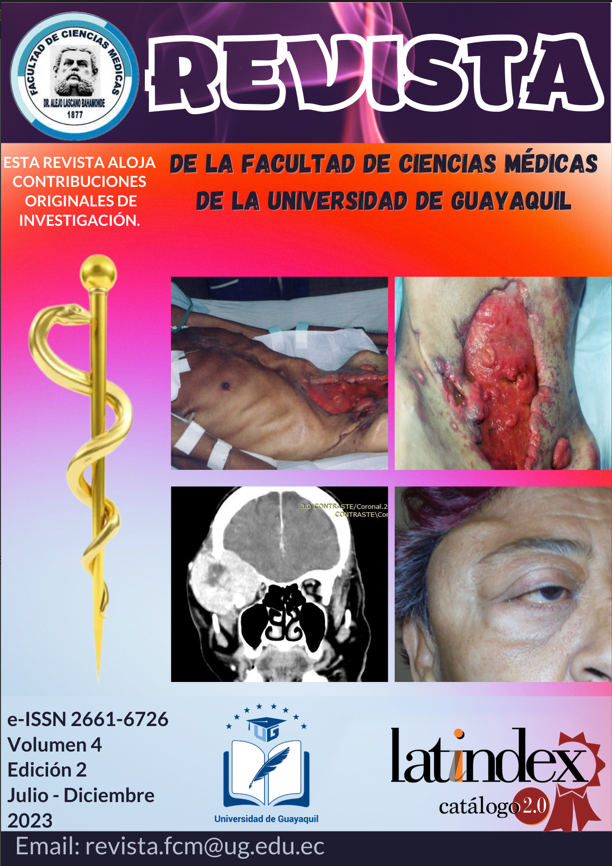Post-surgical abdominal fistulas
Analysis of a Doctoral Thesis
Keywords:
Entero-cutaneous fistula, risk factorsAbstract
In the span of seven years, in the Hospital "Abel Gilbert Ponton" was operated an average of 6825 patients, of these 2.6% were complicated patients (184 patients) and the main complication was the entero-cutaneous fistula 164 patients is say 2.4%, which would be within the margin percentage international fistula production. (thesis Dr. Fernando Moncayo A.)
The co-morbidity factors (62% of the patients in this study had more than 3 factors) influenced the evolution of the patient who underwent surgery, but also the appearance of fistula was observed in patients without them.
The patient's age, nutritional status, comorbid states (cancers, diabetes, inmundeprimido), septic or inflammatory processes that currently owns the patient are gravitating factors (risks) in the occurrence of fistulas. In our study 62% had more than 3 factors. Besides the human factor as the ability to solve problems encountered in surgery, physical and mental fatigue (Burnaut syndrome) are also factors influencing post-surgical complications.
Overall mortality was 13.3%, were re-operated for 8.7% of patients and were not re-operated 4.3%.
References
Morelos Adolfo García Sánchez. fístula. una complicación catastrófica y desafiante. revisión bibliográfica. Revista Ocronos. Vol. VI. Nº 5–Mayo 2023. Pág. Inicial: Vol. VI; nº5: 170. https://doi.org/10.58842/WJBM3798
WAINSTEIN. Fístulas enterocutáneas. Enciclopedia Cirugía Digestiva. F. Galindo y colab. www.sacd.org.ar 2014, Tomo III-255 pág. 1-29.
Manuel Antonio Núñez Marinovich. Factores de riesgo asociados a fístulas enterocutaneas postquirúrgicas en el Hospital Dos de Mayo de enero del 2019 a diciembre del 2021. Lima - Perú 2023.
Navarro-Chagoya MD. Características clínicas de pacientes con abdomen abierto en la UCI. Análisis retrospectivo. Rev. Med Inst Mex Seguro Soc. 2020; 58(2):108-113.
Durán Muñoz-Cruzado VM, Tallón Aguilar L, Tinoco González J, Sánchez Arteaga A, Tamayo López MJ, Pareja Ciuró F, et al. Actualización sobre el manejo de la fístula enterocutánea y fístula enteroatmosférica. Cir Andal. 2019;30(1):40-47.
Katherine del Consuelo Camargo-Hernández, Enf., MSc. Cuidados de enfermería en pacientes con abdomen abierto y fístulas enterocutáneas. MedUNAB [Internet]. 2022;25(2):264-278. doi: https://doi.org/10.29375/01237047.4044
Ana María Caballero Arévalo- Abdomen Hostil: Complicación quirúrgica ulterior a 9 intervenciones. Rev. Cient Cienc Med 2018; 21 (1):107-112
María Paula Villagómez Mayorga. Abordaje del Paciente con Abdomen Abierto. Revisión de la Literatura. Ciencia Latina Revista Científica Multidisciplinar Julio-agosto, 2023, Volumen 7, Número 4. https://doi.org/10.37811/cl_rcm.v7i2.604 p.2
Edwin Oveimar Muñoz-Ruiz. Nueva técnica para control de contaminación de fístulas enteroatmosféricas en abdomen abierto Björck 4. Método de Capilaridad (MECA). Rev. Colomb Cir. 2022; 37:90-5 https://doi.org/10.30944/20117582.939
María José Vera Sánchez. manejo multidisciplinario del abdomen catastrófico en el servicio de cirugía general, del hospital de especialidades eugenio espejo. Tesis QUITO, 2019.





